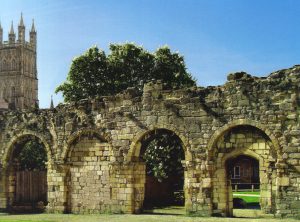 The third novel in my Lady Apollonia West Country Mysteries, Memento Mori, is set in medieval Gloucester of 1392. In this posting, I would like to discuss the monastic situation in the city at that time which included a Benedictine abbey, two Augustinian priories, and three orders of friars.
The third novel in my Lady Apollonia West Country Mysteries, Memento Mori, is set in medieval Gloucester of 1392. In this posting, I would like to discuss the monastic situation in the city at that time which included a Benedictine abbey, two Augustinian priories, and three orders of friars.
Last month my postings concerned the Abbey of Saint Peter which was Benedictine in 1392 and evolved later into Gloucester Cathedral. This monastery was important in my story, and you can read more about it in my March postings.
Another Benedictine foundation was Saint Oswald’s Priory which also played a role in my story. Saint Oswald’s had been founded by Queen Aethelflaeda, daughter of Alfred the Great. It was located on the northwest side of the city and was named for a Northumbrian king and martyr, killed at the Battle of Maserfield in 641 AD, whose body parts were eventually brought in 909 AD to be buried at the new priory. A few years later Aethelfraeda, as well as her husband, Aethelred, were also probably buried at Saint Oswald’s.
After the Norman Conquest, the fortunes of Saint Oswald’s began to wane despite its becoming Augustinian. This was partly because it fell into the hands of the Archbishop of York who was in an acrimonious relationship with the Bishop of Worcester in whose jurisdiction the city of Gloucester resided. One of the villains in my story is a dissolute monk in this priory which had seen better days. At the time of the Dissolution of the monasteries by King Henry VIII, the priory was made up of only seven monks. Part of the priory church building was preserved as a parish church but was heavily damaged in the English Civil War. Today, English Heritage maintains what is left of the ruins, little more than a few arches, as shown above. Note the cathedral tower in the background.
Another Augustinian priory has only an indirect relation to my story. It was founded around 1150 southwest of the city as Llanthony Secunda after Llanthony Priory in Wales which had been overrun by rebels. This new Gloucester priory survived and thrived even after the Welsh version was reopened four years later. By the Dissolution in 1538, Llanthony Priory in Gloucester was among the richest Augustinian houses in England. Its holdings included 97 churches, including some in Gloucester. Among them was the Chapel of Saint Kyneburgh which I featured in my last posting.
Three friaries came to Gloucester in the 13th century: the Greyfriars or Franciscans, the Blackfriars or Dominicans, and Whitefriars or Carmelites. Nothing remains of the Whitefriars, but there are ruins of the Greyfriars from their rebuilding in the early 16th century. The remains of the Blackfriars in Gloucester date from 1239, and it is the most complete Surviving Dominican Friary in England.
Tags: Chaucer's England, historical fiction, medieval mysteries